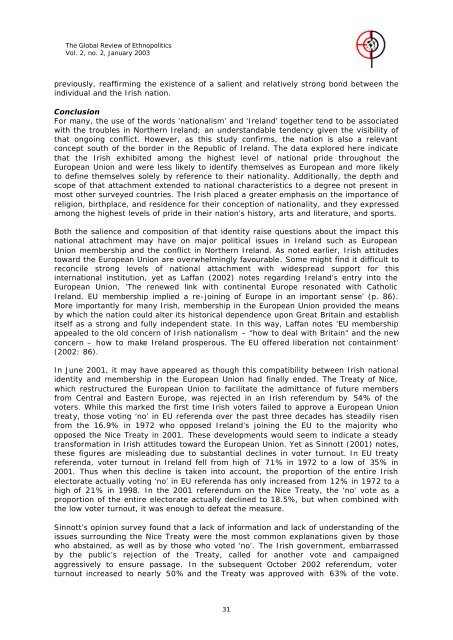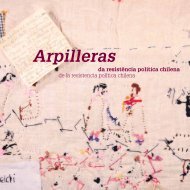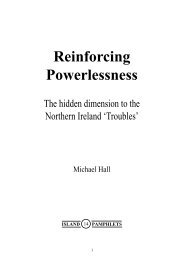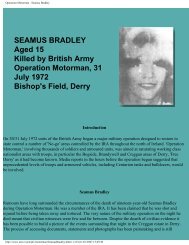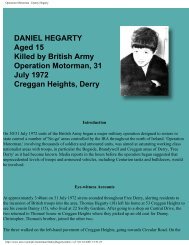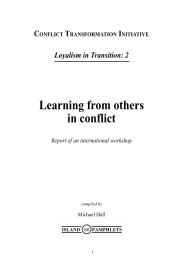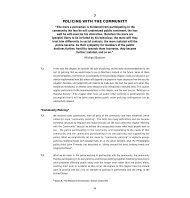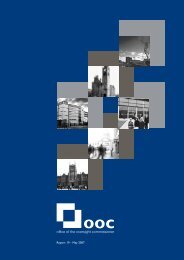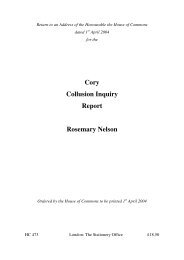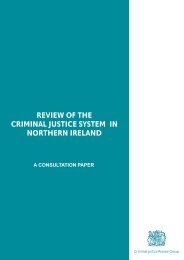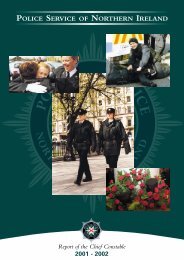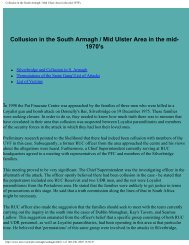The Irish and their Nation: A Survey of Recent Attitudes ... - CAIN
The Irish and their Nation: A Survey of Recent Attitudes ... - CAIN
The Irish and their Nation: A Survey of Recent Attitudes ... - CAIN
Create successful ePaper yourself
Turn your PDF publications into a flip-book with our unique Google optimized e-Paper software.
<strong>The</strong> Global Review <strong>of</strong> EthnopoliticsVol. 2, no. 2, January 2003previously, reaffirming the existence <strong>of</strong> a salient <strong>and</strong> relatively strong bond between theindividual <strong>and</strong> the <strong>Irish</strong> nation.ConclusionFor many, the use <strong>of</strong> the words ‘nationalism’ <strong>and</strong> ‘Irel<strong>and</strong>’ together tend to be associatedwith the troubles in Northern Irel<strong>and</strong>; an underst<strong>and</strong>able tendency given the visibility <strong>of</strong>that ongoing conflict. However, as this study confirms, the nation is also a relevantconcept south <strong>of</strong> the border in the Republic <strong>of</strong> Irel<strong>and</strong>. <strong>The</strong> data explored here indicatethat the <strong>Irish</strong> exhibited among the highest level <strong>of</strong> national pride throughout theEuropean Union <strong>and</strong> were less likely to identify themselves as European <strong>and</strong> more likelyto define themselves solely by reference to <strong>their</strong> nationality. Additionally, the depth <strong>and</strong>scope <strong>of</strong> that attachment extended to national characteristics to a degree not present inmost other surveyed countries. <strong>The</strong> <strong>Irish</strong> placed a greater emphasis on the importance <strong>of</strong>religion, birthplace, <strong>and</strong> residence for <strong>their</strong> conception <strong>of</strong> nationality, <strong>and</strong> they expressedamong the highest levels <strong>of</strong> pride in <strong>their</strong> nation’s history, arts <strong>and</strong> literature, <strong>and</strong> sports.Both the salience <strong>and</strong> composition <strong>of</strong> that identity raise questions about the impact thisnational attachment may have on major political issues in Irel<strong>and</strong> such as EuropeanUnion membership <strong>and</strong> the conflict in Northern Irel<strong>and</strong>. As noted earlier, <strong>Irish</strong> attitudestoward the European Union are overwhelmingly favourable. Some might find it difficult toreconcile strong levels <strong>of</strong> national attachment with widespread support for thisinternational institution, yet as Laffan (2002) notes regarding Irel<strong>and</strong>’s entry into theEuropean Union, ‘<strong>The</strong> renewed link with continental Europe resonated with CatholicIrel<strong>and</strong>. EU membership implied a re-joining <strong>of</strong> Europe in an important sense’ (p. 86).More importantly for many <strong>Irish</strong>, membership in the European Union provided the meansby which the nation could alter its historical dependence upon Great Britain <strong>and</strong> establishitself as a strong <strong>and</strong> fully independent state. In this way, Laffan notes ‘EU membershipappealed to the old concern <strong>of</strong> <strong>Irish</strong> nationalism – “how to deal with Britain” <strong>and</strong> the newconcern – how to make Irel<strong>and</strong> prosperous. <strong>The</strong> EU <strong>of</strong>fered liberation not containment’(2002: 86).In June 2001, it may have appeared as though this compatibility between <strong>Irish</strong> nationalidentity <strong>and</strong> membership in the European Union had finally ended. <strong>The</strong> Treaty <strong>of</strong> Nice,which restructured the European Union to facilitate the admittance <strong>of</strong> future membersfrom Central <strong>and</strong> Eastern Europe, was rejected in an <strong>Irish</strong> referendum by 54% <strong>of</strong> thevoters. While this marked the first time <strong>Irish</strong> voters failed to approve a European Uniontreaty, those voting ‘no’ in EU referenda over the past three decades has steadily risenfrom the 16.9% in 1972 who opposed Irel<strong>and</strong>’s joining the EU to the majority whoopposed the Nice Treaty in 2001. <strong>The</strong>se developments would seem to indicate a steadytransformation in <strong>Irish</strong> attitudes toward the European Union. Yet as Sinnott (2001) notes,these figures are misleading due to substantial declines in voter turnout. In EU treatyreferenda, voter turnout in Irel<strong>and</strong> fell from high <strong>of</strong> 71% in 1972 to a low <strong>of</strong> 35% in2001. Thus when this decline is taken into account, the proportion <strong>of</strong> the entire <strong>Irish</strong>electorate actually voting ‘no’ in EU referenda has only increased from 12% in 1972 to ahigh <strong>of</strong> 21% in 1998. In the 2001 referendum on the Nice Treaty, the ‘no’ vote as aproportion <strong>of</strong> the entire electorate actually declined to 18.5%, but when combined withthe low voter turnout, it was enough to defeat the measure.Sinnott’s opinion survey found that a lack <strong>of</strong> information <strong>and</strong> lack <strong>of</strong> underst<strong>and</strong>ing <strong>of</strong> theissues surrounding the Nice Treaty were the most common explanations given by thosewho abstained, as well as by those who voted ‘no’. <strong>The</strong> <strong>Irish</strong> government, embarrassedby the public’s rejection <strong>of</strong> the Treaty, called for another vote <strong>and</strong> campaignedaggressively to ensure passage. In the subsequent October 2002 referendum, voterturnout increased to nearly 50% <strong>and</strong> the Treaty was approved with 63% <strong>of</strong> the vote.31


